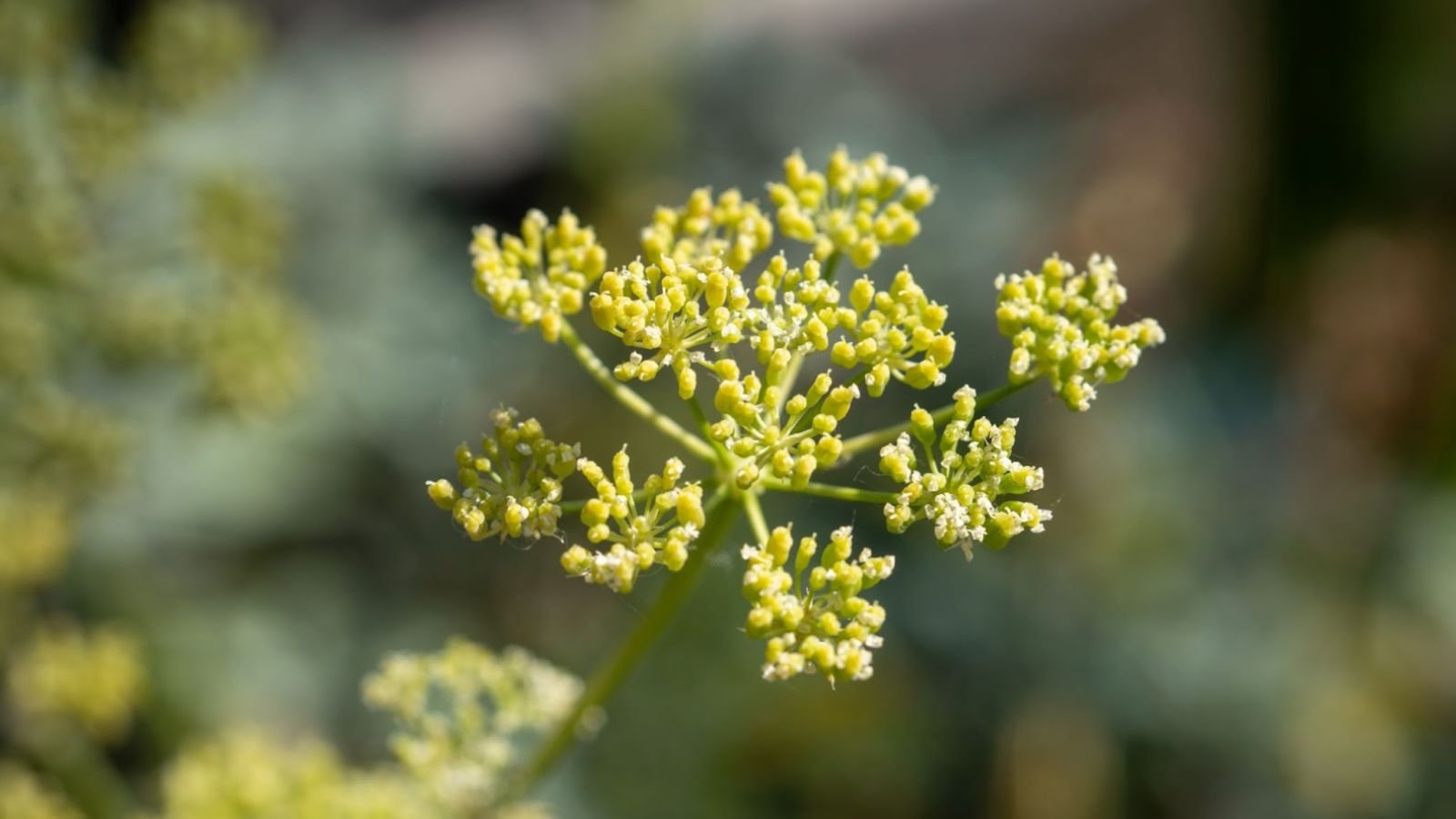Herbs are special plants we grow for many reasons. They’re not just pretty—they often have medicinal or edible uses and attract pollinators with their nutritious flowers. Add sunshiney ornamental charm alongside edible usage by planting herbs with yellow flowers in your garden.
With thousands of kinds that grow, there are ones for tea making, some for meal flavoring, and others for fresh eating. Select the right picks for you by selecting the types you think are pretty and the ones you can utilize in your kitchen. Herbs with yellow flowers mix and match pleasingly with most other colors, especially white, orange, and red. Use yellow to paint your garden a warm palette.
Maybe you have an empty border where you’d like to grow sun-loving plants. Or, your vegetable beds could use insect-attracting perennials to help increase pollination rates. Whatever your needs are, herbs with yellow flowers step up and deliver amazing results. Try a few this year, and you’ll be growing herbs for decades!
These herbs include annuals, perennials, and herbaceous perennials. There are options for any grower, no matter what part of North America you garden in. Without further ado, here are 19 herbs with yellow flowers you’ll want to plant this season.
Parsley
A hardy biennial, parsley sticks around in mild winter zones for two years before it dies. You’ll harvest its edible leaves for months after planting, so you’ll save lots of money not buying fresh herbs. Parsley’s peppery flavor and vigorous growth make it one of the most versatile plants you’ll ever grow.
Growers treat this herb as an annual and plant it in winter or spring after their last average frost date. Within zones 5 through 9, parsley matures over two years. You’ll have lots of leafy growth the first year and tons of yellow-white flowers and seeds the second. In these zones, plant it in the fall or early spring for the best harvesting results.
There are a few options when it comes to parsley varieties. The most decorative is moss-curled parsley or curly parsley. You see these two types commonly garnishing dinner plates. They also make excellent seasonings, both fresh and dried. For a flat type, try Italian flat-leaf parsley. It works well in recipes because it’s easier to chop than the curly kinds.
German Chamomile
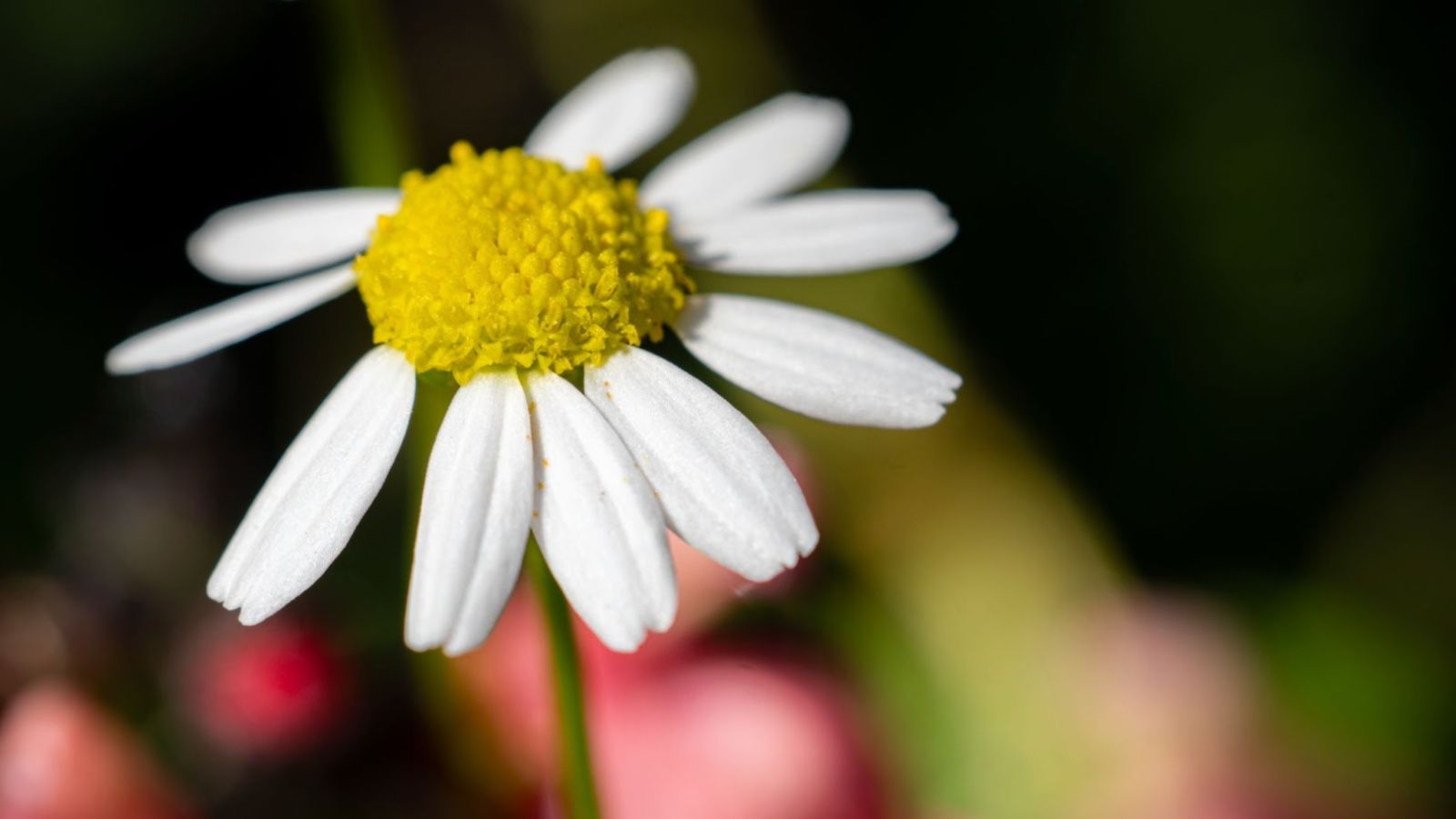
German chamomile is the best chamomile herb variety you can grow for edible yellow flowers. The blossoms make a delicious, soothing tea that calms nerves, relieves stress, and eases anxiety. I scatter seeds annually for a yearly supply of this calming herb, but it sometimes pops up on its own!
German chamomile sprouts bright yellow-centered flowers with white petals. Its foliage is lacey green, with leaves decorating the lower parts of the plant. In midsummer, flowering stems shoot upward with a profusion of white-yellow blooms. Harvest these blooms and dry them to make a homemade chamomile tea blend.
Start German chamomile from seeds in spring, after all danger of frost has passed. They’ll sprout and grow quickly over the growing season, giving you edible blooms two to three months after planting. This annual needs consistent moisture, so water well if the soil dries. Alternatively, start seeds in the fall and give them at least two weeks of cold. You’ll have a nice crop of chamomile in mild fall regions.
Nasturtium
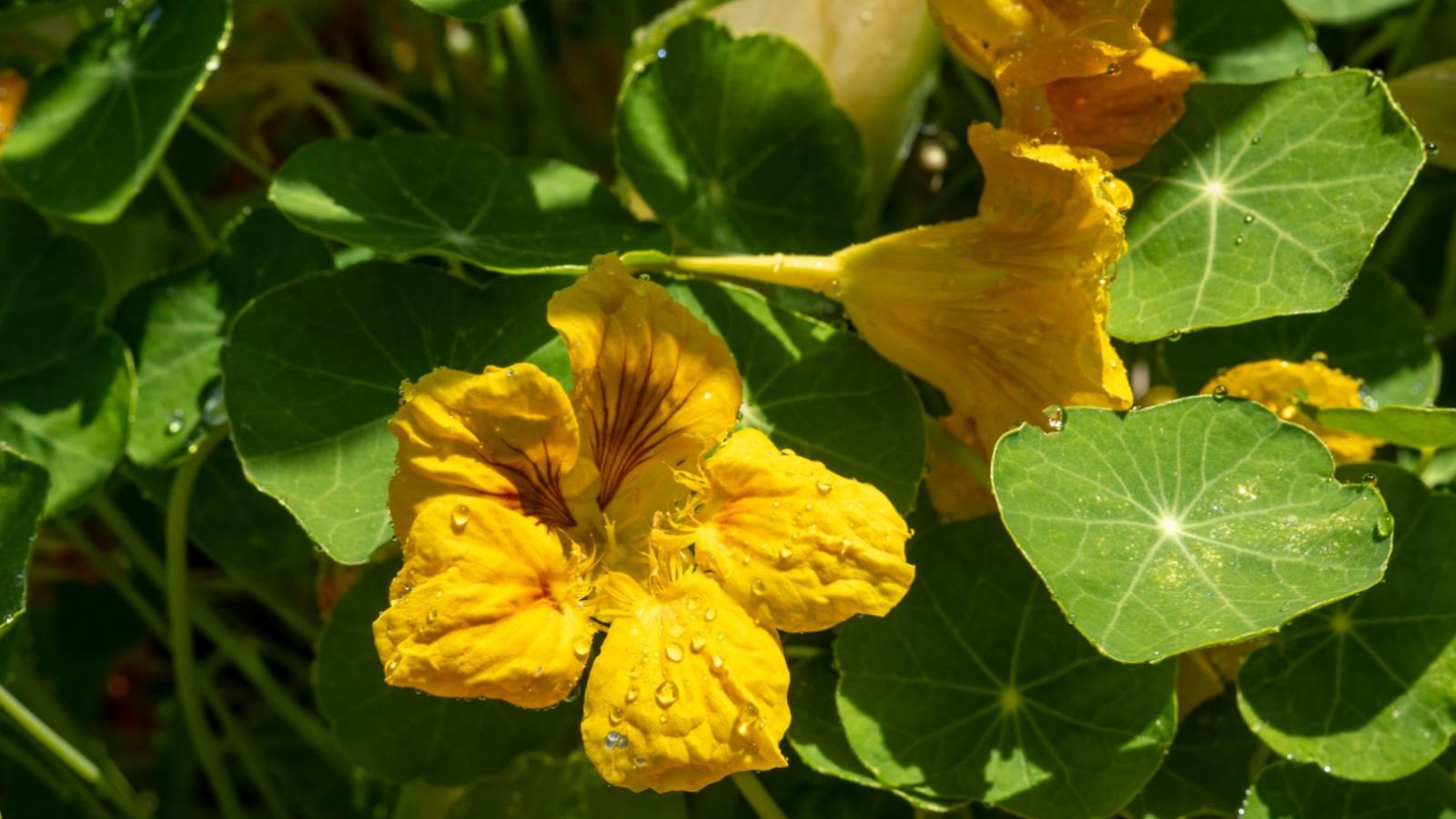
Plant nasturtiums this year, and you’ll never have to plant them again! Even in cold winter zones 6 through 8, this annual reseeds readily. It dies with the first frost but quickly resprouts in spring from new seeds. This herb’s yellow flowers, young seeds, and leaves are all edible; just know they have a peppery kick!
Nasturtiums come in reds, whites, oranges, and yellows. The yellow types are particularly stunning, as their flowers contrast beautifully with the dark green or variegated round leaves they sprout. Try varieties like ‘Butterscotch’ for a range of yellow colors from peach to gold.
Although this annual spreads readily, you do have some control over where new seedlings grow. When they have more than five true leaves, you can transplant them into new areas. Let’s say nasturtiums sprout in your vegetable beds—dig them up, relocate them, and water the new site well. They’ll adapt over a week or two before resuming steady growth.
Purslane
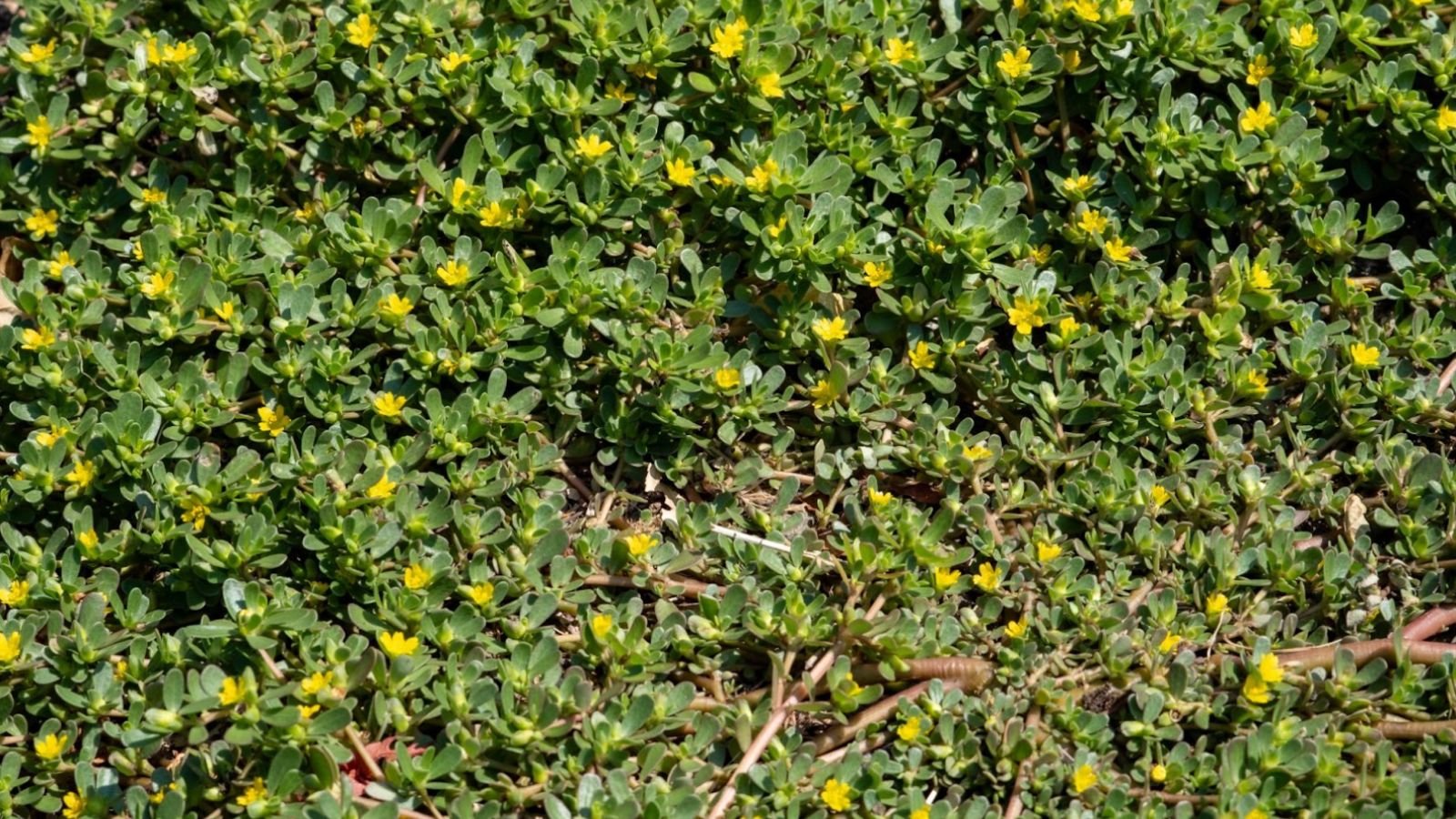
Purslane is a common weedy plant that sprouts on disturbed soils. It thrives under direct sunlight, filling bare soil quickly with spreading tendrils. Round succulent leaves sprout from its stems. They’re edible when cooked and fresh.
Purslane sprouts from seeds and broken stems. This herb quickly claims bare areas in summer, blooming dozens of yellow flowers. The flowers mature into seed capsules that release new seeds. They’ll germinate next spring, and help the population spread slowly over the entire area.
Reduce purslane weeds from your garden by uprooting them and preparing them in your favorite recipes. The greens work similarly to Swiss chard or spinach. Blend them in smoothies, fry them in sautés, or chop them fresh in salads. Be sure to rinse the greens well before you use them, as purslane grows low to the ground and may collect dirt on its underside.
‘Moonshine’ Yarrow
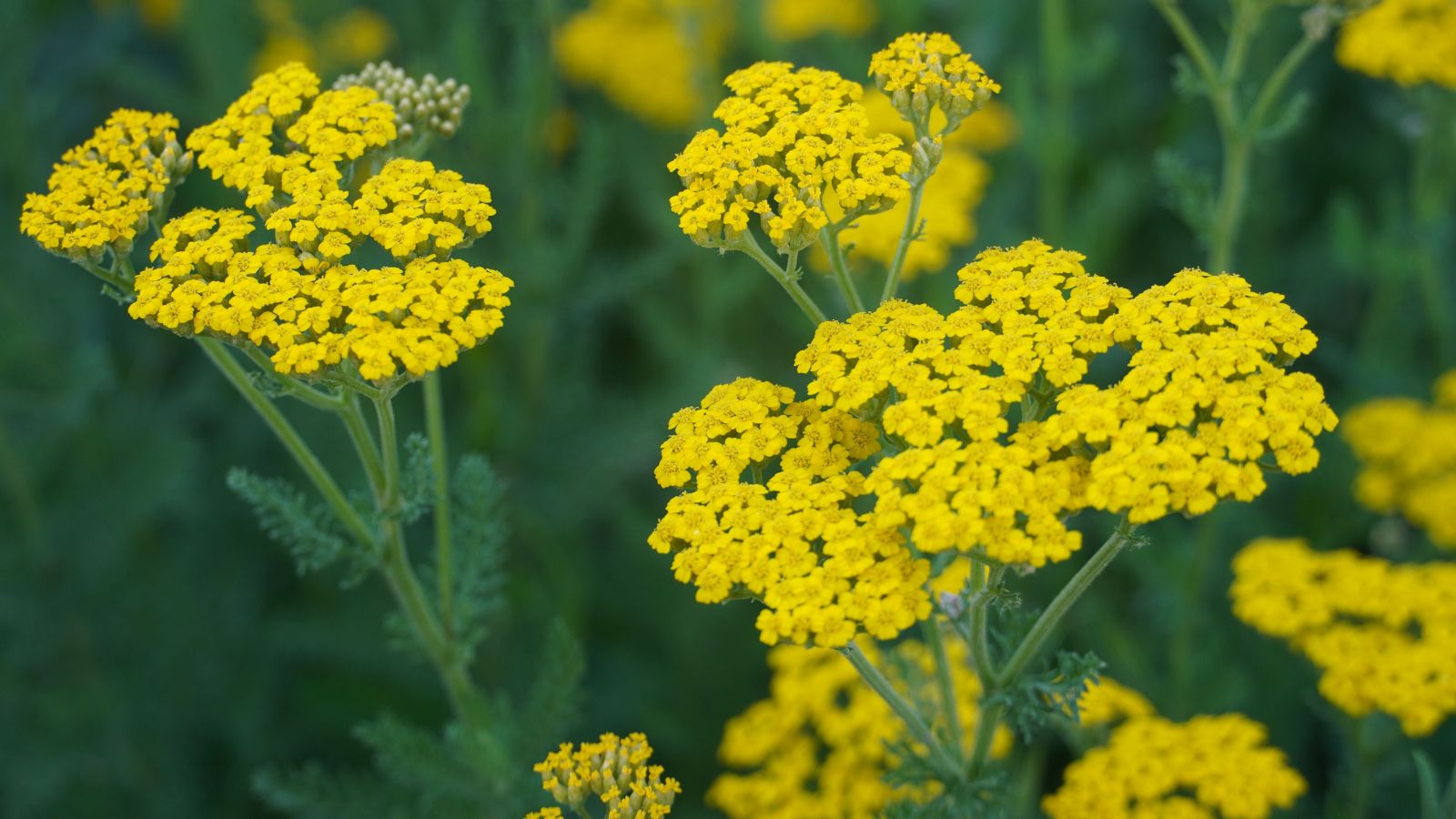
This perennial wildflower pockets landscapes in North America, Africa, Europe, and Asia. Common yarrow sprouts white umbels, but the ‘Moonshine’ variety grows golden yellow flowers en masse. Hardy and tough, ‘Moonshine’ excels in most gardens from plant hardiness zones 3 through 9. Use its dried flowers in bouquet arrangements or steep them to make tea.
Yarrow lures pollinators in with its clusters of hundreds of blossoms—bees appreciate the pollen and nectar, and they like to rest on the umbels. Flowers sprout so close together on these umbels that they make a landing pad for bees and similar pollinating insects. Grow ‘Moonshine’ in your garden to see plenty of tired bees resting on the blossom pads.
Find ‘Moonshine’ available at your local nursery or online. Other yellow-flowering yarrow varieties exist too like ‘Little Moonshine’ and ‘Coronation Gold.’ Find one that performs well in your area for optimal growing success.
Dill
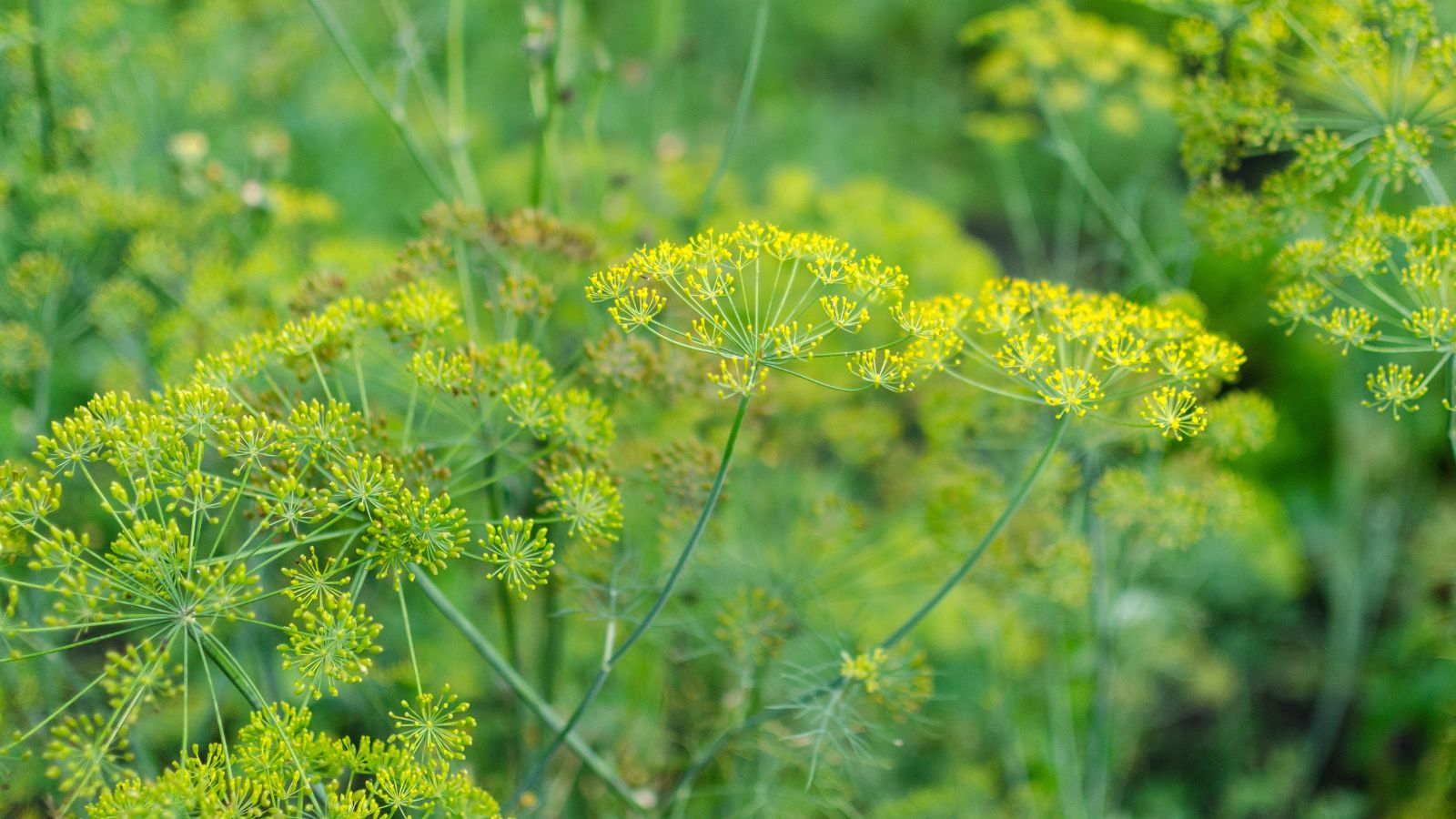
Dill is unique—it grows as an annual, perennial, or biennial depending on the local climate! Treat it as an annual in plant hardiness zone 1, biennial in zones 2 through 8, and perennial in zones 9 through 11. Dill reseeds readily, so if your plants die, there are likely more on the way.
Dill is essential for pickles and seasoning seafood dishes. Scatter seeds in your herb garden in early spring for pleasant-smelling leaves all summer. This herb sprouts yellow flower umbels in midsummer, maturing into bunches of seeds. Use leaves, flowers, and seeds as seasonings in your kitchen.
Dill is larger than other herbs like parsley and oregano; it quickly matures from a small plant into a five-foot-tall giant. Situate it where it has room to spread out. Like nasturtiums, seedlings sprout readily in warm weather. Transplant them when they have a few true leaves wherever you’d like more dill to grow.
Fennel
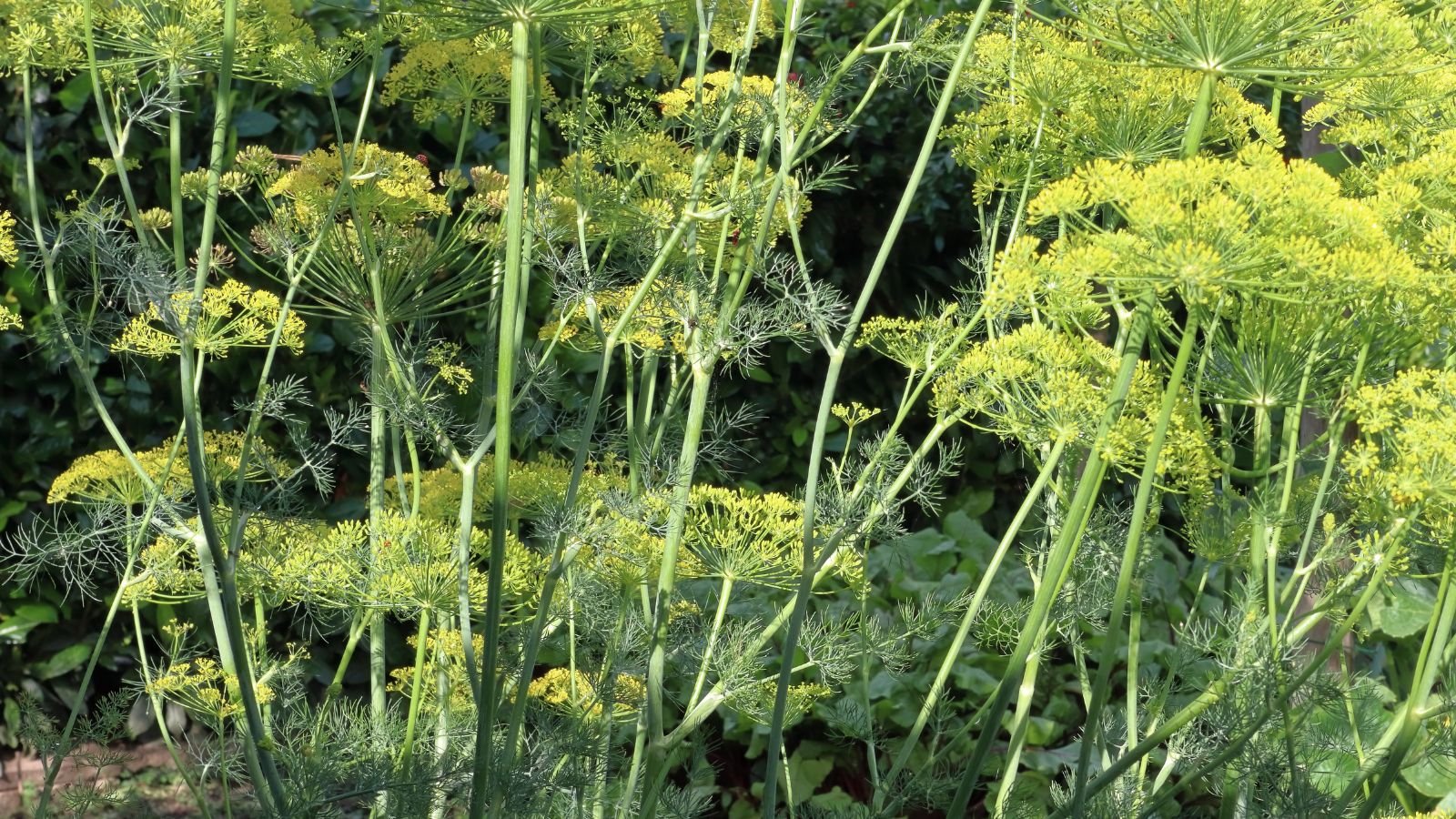
You may have seen fennel growing around—it’s native to the Mediterranean but naturalizes in North American landscapes. It does this so well, it’s considered an invasive species in many parts of North America.
Finely cut aromatic leaves sprout from central bulbs. Stalks bolt from this herb’s bulbs and form large yellow flower umbels; these mature into aromatic fennel seeds. Seeds, leaves, and bulbs smell like anise. They lend strong flavors to recipes.
Some garden fennel varieties exist with unique attributes. Try ‘Dragon’ for giant bulbs that are slow to bolt, meaning you can grow this type in warm temperatures, unlike most fennels. ‘Finnochio’ and ‘Romanesco’ sprout uniform bulbs with mild flavor. They’re perfect as dependable crops for hardiness zones 4 through 9.
When to sow fennel seeds depends on your winter conditions. Mild winter growers should sow seeds in the fall for a winter harvest. Cool summer growers can plant seeds after their last average frost date. All other gardeners should plant fennel in midsummer for a fall harvest.
Pot Marigold
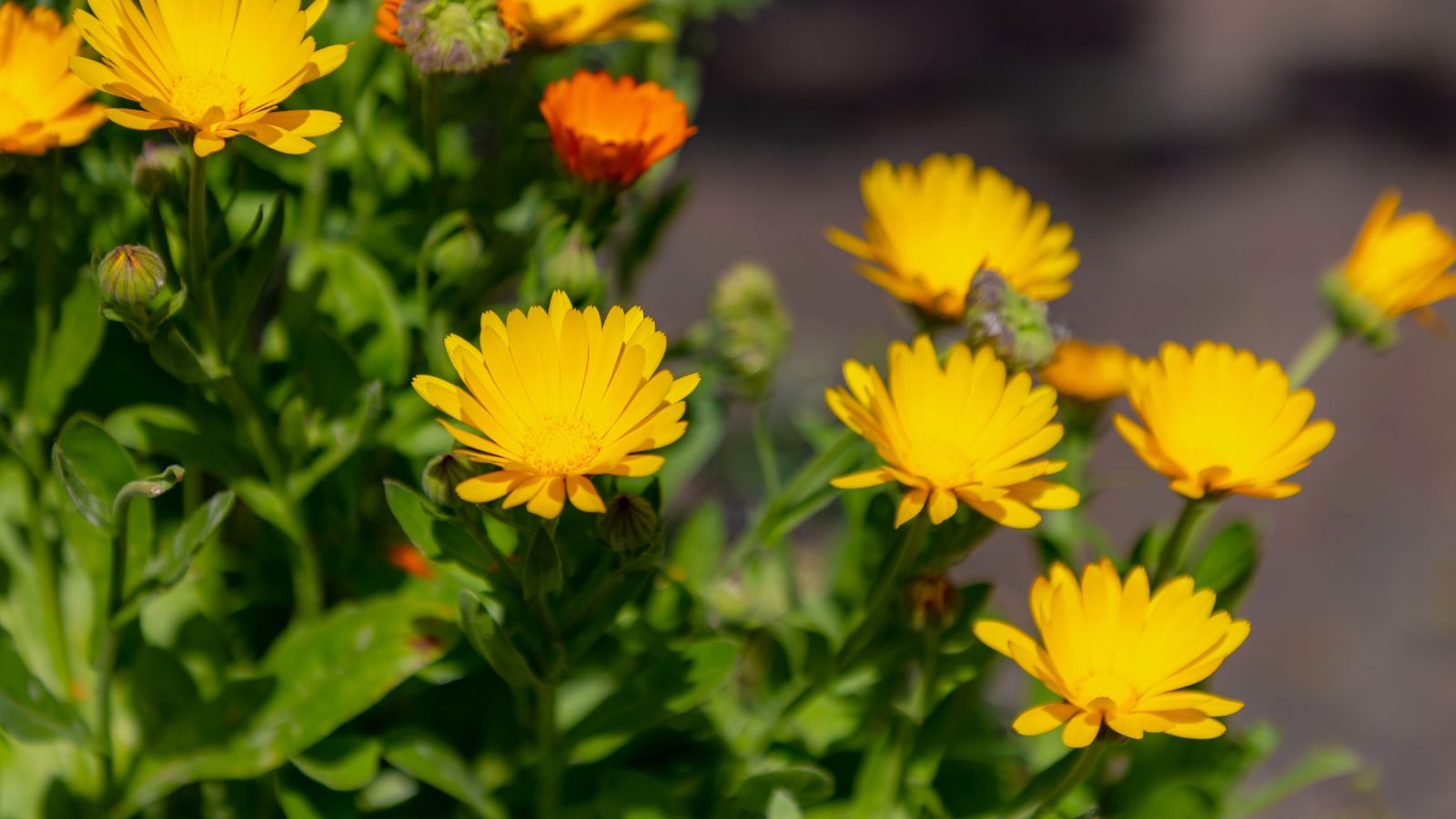
Pot marigolds (Calendula spp.) are decorative annual plants with orange and yellow flowers. The yellow flower petals of this herb are entirely edible, and add a floral taste to salads, casseroles, and vinegar infusions. The plants are ideal in borders, raised beds, and containers—plant them alongside the other marigolds (Tagetes) for a full presentation of colorful blooms.
These annuals readily reseed when they’re happy; cut their spent blooms to encourage more blooms, and to discourage reseeding. Pot marigolds appreciate full sun, but will benefit from afternoon shade in hot summer zones. Give them good drainage and moderate water, and they’ll give you dozens of flowers.
Start this herb in your garden by sowing seeds after your last average frost date. They’ll germinate during spring and sprout flowers by summer. The variety ‘Resina’ grows yellow-orange petals full of flavor, and works well as an edging plant. Use ‘Pacific Beauty Blend’ for double-petalled flowers that make a statement wherever they grow.
Pansy
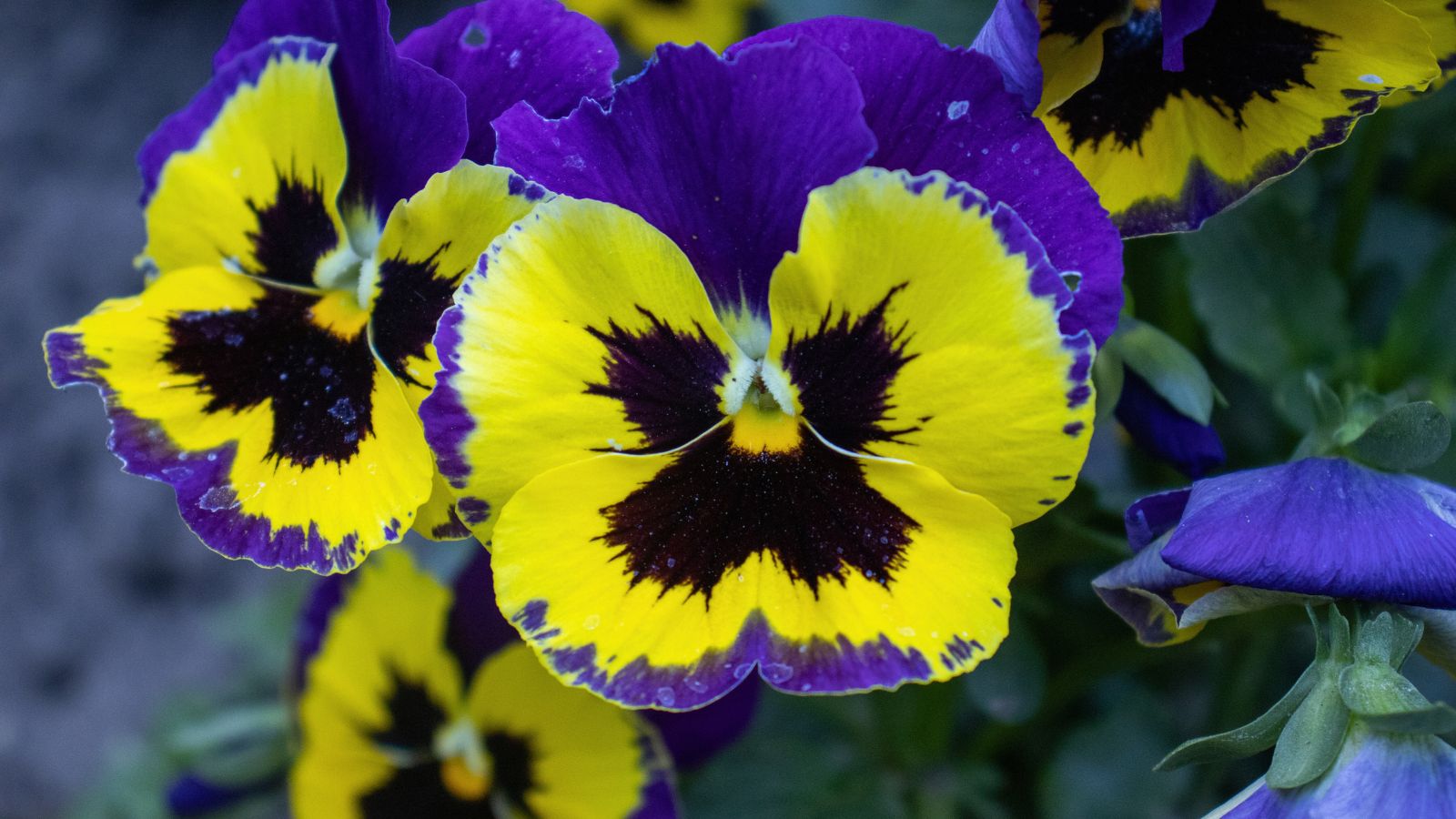
This popular bedding plant also happens to sprout tasty, edible flowers. Pansies thrive when other plants struggle, during cool, wet weather. They’re often the one plant I purchase annually, as new varieties sport unique patterns and colors that weren’t available the year before. Plant pansies in the fall for flowers from winter until summer.
Only eat pansy flowers from plants you know are pesticide and herbicide-free—some growers spray these hybrids with systemic chemicals. Plants with organic certifications are safe to eat after a good rinsing. If you’re unsure, ask the growers at the store where you bought the plants how they treat them.
Pansies are perennials, although they typically die after a few years if they survive the summer. Warm temperatures and low moisture will kill these plants—most gardeners treat them as annuals from fall through spring. Mulch them in winter if you routinely receive frost or snow.
Sweet Bay
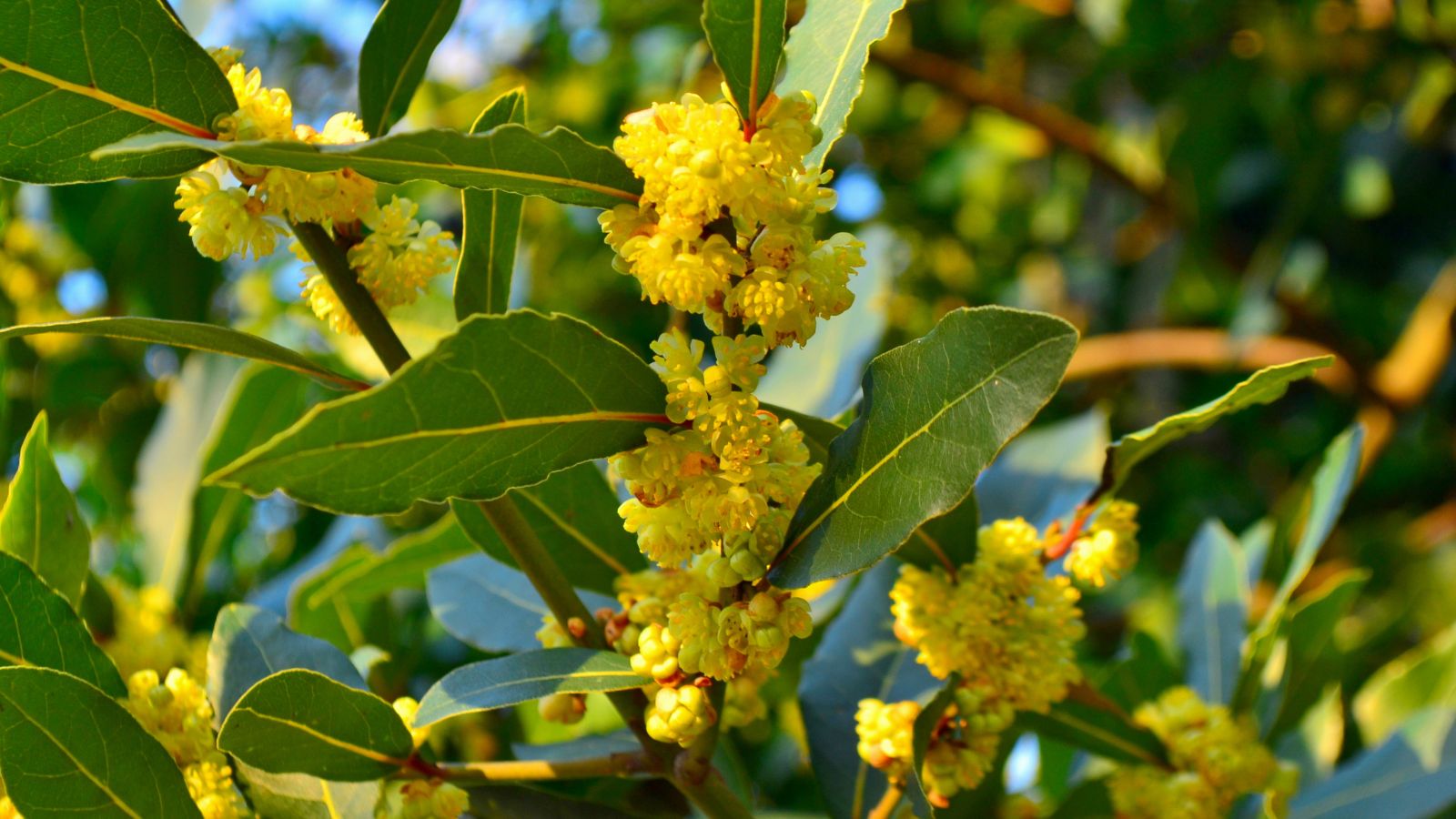
Unlike other herbs on this list, sweet bay is a yellow-flowering tree. This Mediterranean native plant grows 60 feet tall in its original habitat! It stays between eight and twelve feet in North America and is easy to maintain in a container. Grow sweet bay for fresh or dried bay leaves to flavor soups, stews, and marinades. The leaves are toxic if you eat too many of them, so use them as a seasoning and take them out before serving your meals.
Sweet bay isn’t cold hardy, so it needs some winter protection in zone 8. This tree thrives outdoors year-round in the ground or in a container in zones 9 and 10. Give it rich, free-draining soil and regular water during the growing season. Harvest its leaves by cutting off entire stems. Place fresh leaves in the refrigerator to store them for two weeks, or dry them for long-term storage up to a year.
Sweet bay sprouts white-yellow flowers when trees mature to their adult size. The petals are white and the stamens or pistils are yellow. This tree is dioecious, meaning there are separate plants with female or male flowers. Find trees that sprout female flowers if you’d like to grow the fruits. They aren’t edible, but they contain seeds that propagate more sweet bay seedlings.
Mexican Tarragon
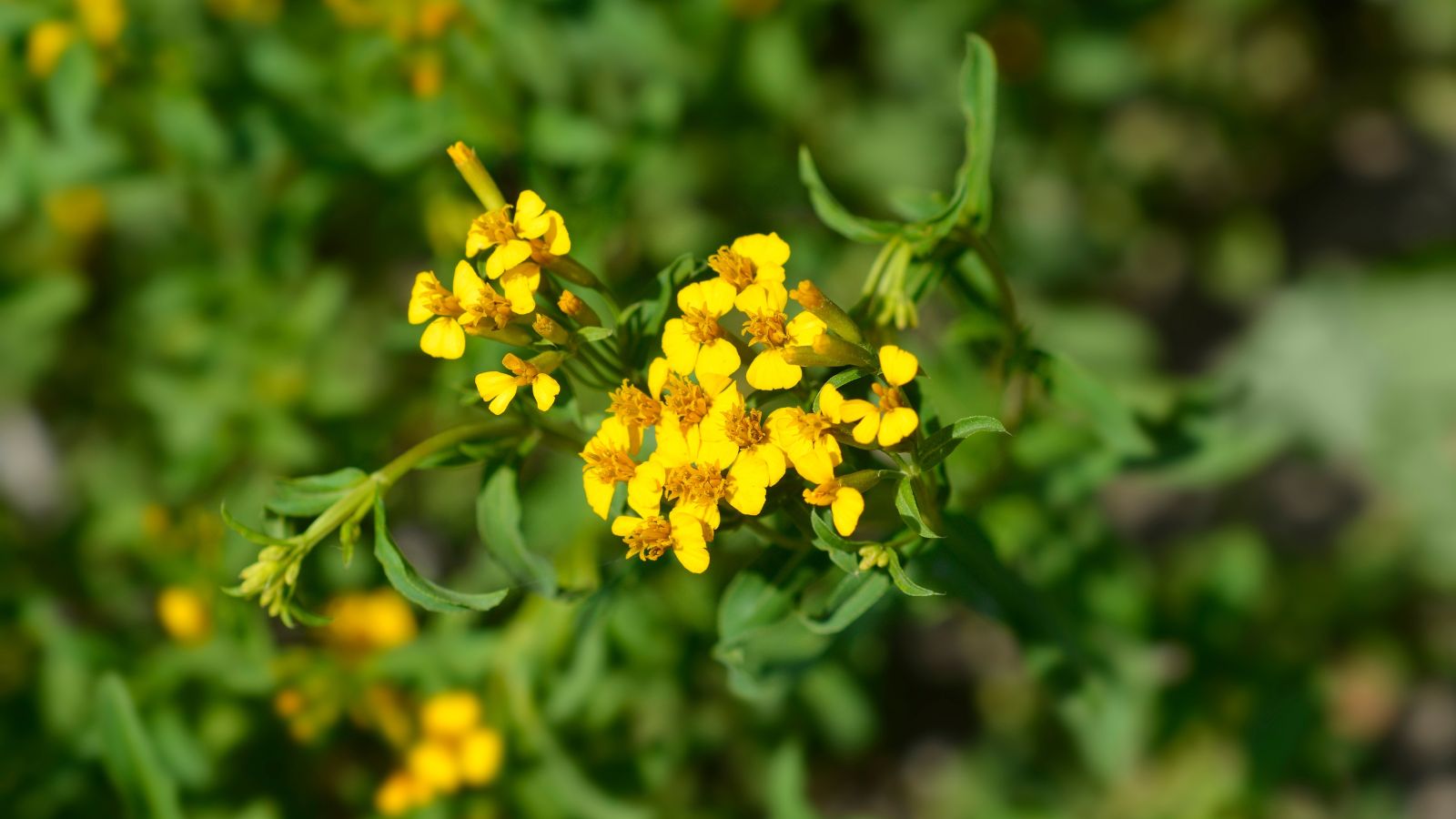
A summer annual with sunflower-like charm, Mexican tarragon is the perfect herb to add to hot, sunny gardens. It’s perennial from zones 8 through 11, although it doesn’t appreciate soggy, cold soils. Put it amongst your heat-loving vegetables to attract pollinators—this tarragon blooms yellow-orange edible flowers that taste like anise.
Although edible, this tarragon may be harmful if you eat too much. Restrict it to usage of teas, seasoning, and marinades to reduce any unwanted side effects. If you’d rather not eat it, plant it to attract pollinating insects to your gardens. Cut flowers make excellent dry or fresh floral arrangements, especially among yellow flowers like sunflowers, marigolds, and yellow yarrows.
Start this perennial from seeds indoors six to eight weeks before your last average frost date. This ensures they get a head start on the growing season so they bloom from spring through summer. Transplant seedlings outside once the danger of frost has passed.
Rue
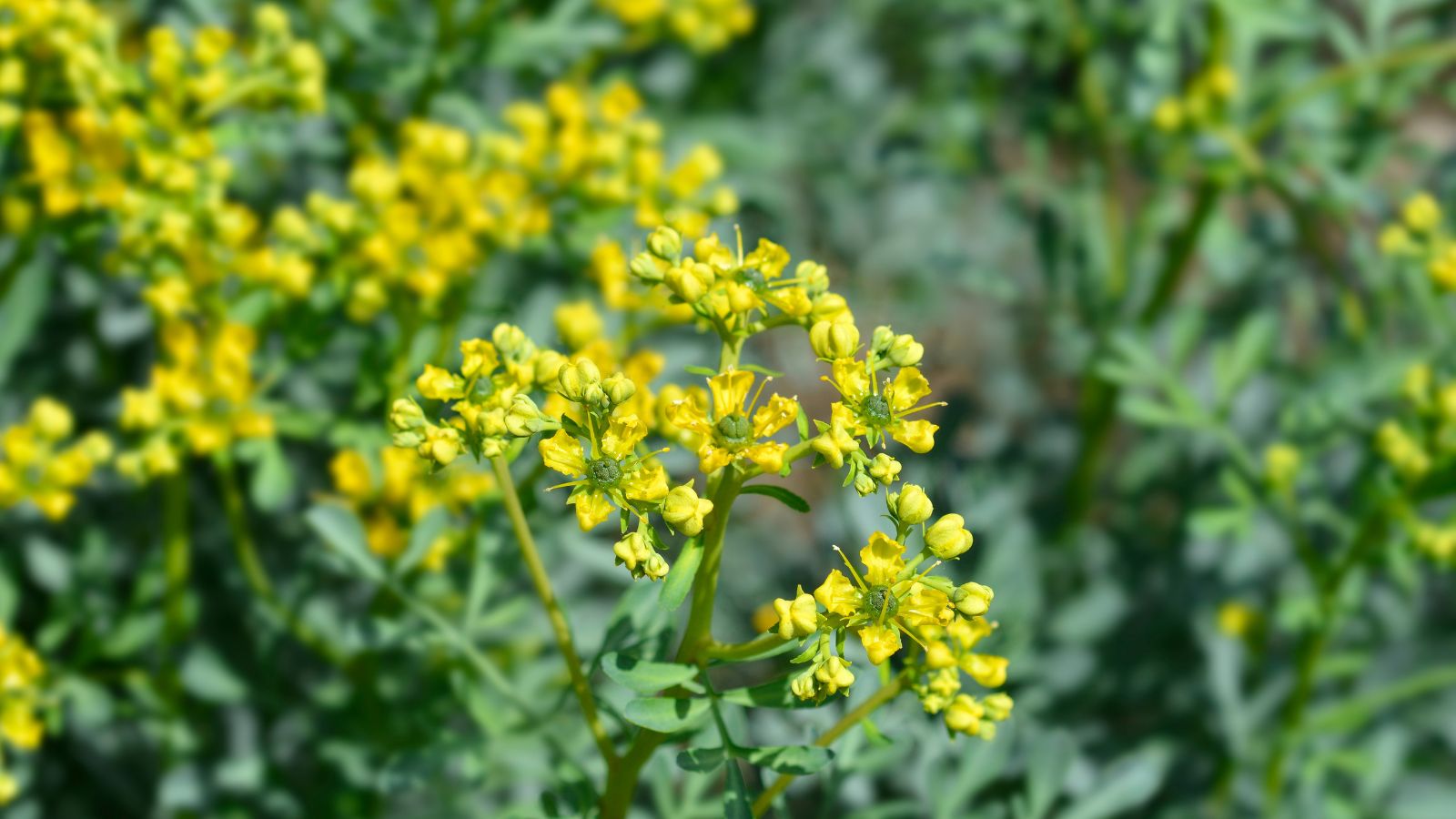
Rue plants are aromatic herbs with stately statures. They bloom yellow flowers with green centers, and they add ornamental charm wherever you plant them. Attract butterflies, bees, and pollinating flies with a rue plant or two; space them throughout your garden to fill empty soil.
Rue is perennial and evergreen in warm winter gardens. They’ll die back where frost is common, although fresh growth springs back when snow melts and days lengthen. Simply prune back your plants to woody stems in early spring, and watch as rue comes back to life.
Start rue from seeds in spring. They need warm temperatures to germinate, and frost may kill tender seedlings. Sprout them inside two to four weeks before your last average frost date to transplant outside when cold danger passes.
Yellow Coneflower
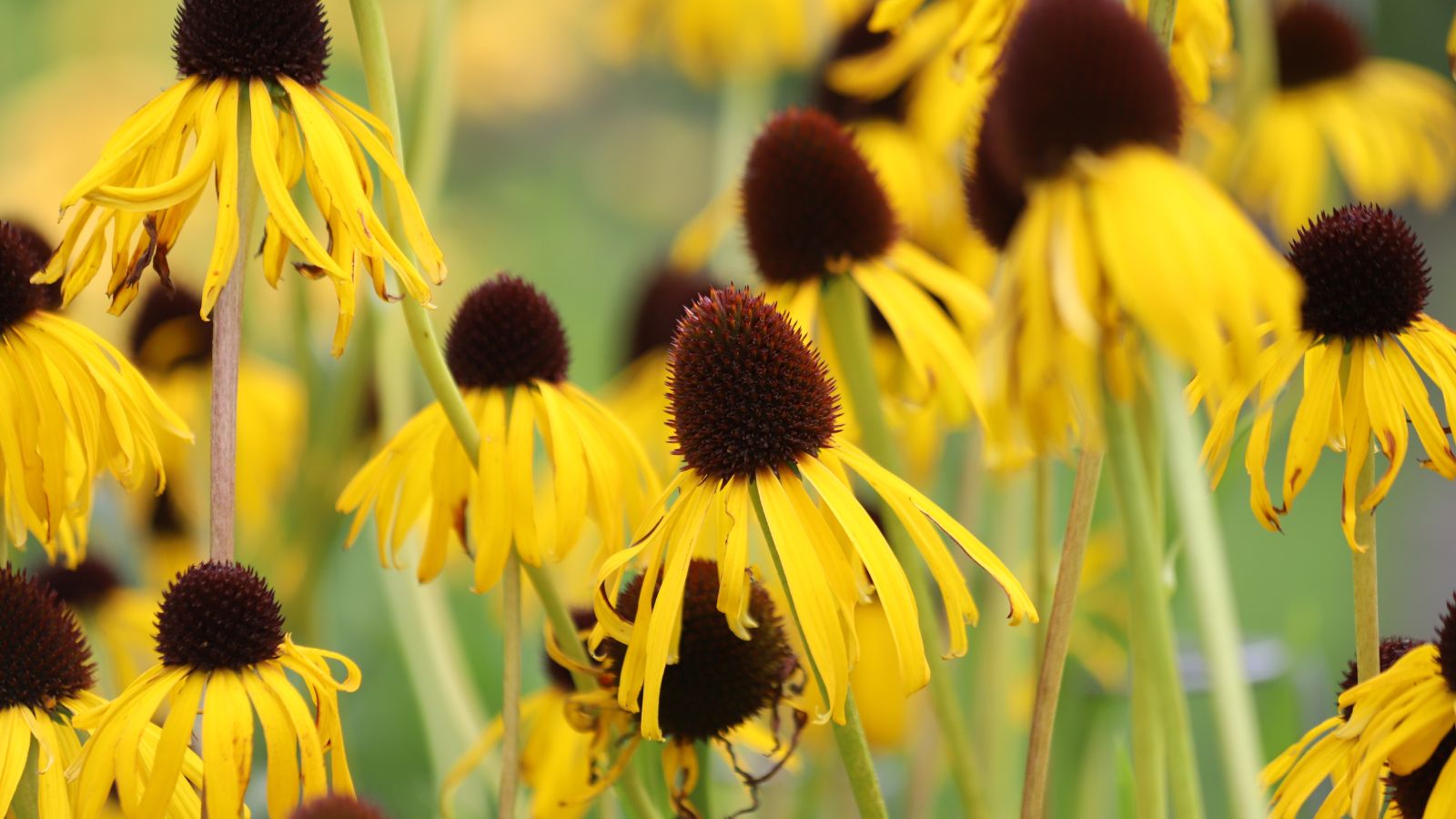
Yellow coneflower combines the attractive yellow color of black-eyed Susans with the formal structure of purple coneflowers. Like these other two species, yellow coneflower is native to the United States. It thrives in meadows, prairies, and grasslands in eastern states like Texas, Oklahoma, and Arkansas.
Give yellow coneflower good drainage and it’ll thrive in most locations. It struggles in wet soils that stay moist; they rot out the roots. Use organically rich, well-draining soil to avoid root rot. This perennial sprouts a taproot that digs deep into the dirt. During droughts, this taproot holds water to keep itself alive despite arid conditions.
Wherever black-eyed Susans and purple coneflowers thrive, yellow coneflower thrives. Use it to attract pollinators. The seeds lure birds, promising a tasty snack. Pollinator gardens, vegetable beds, and ornamental landscapes all benefit from yellow coneflower’s presence.
St. John’s Wort
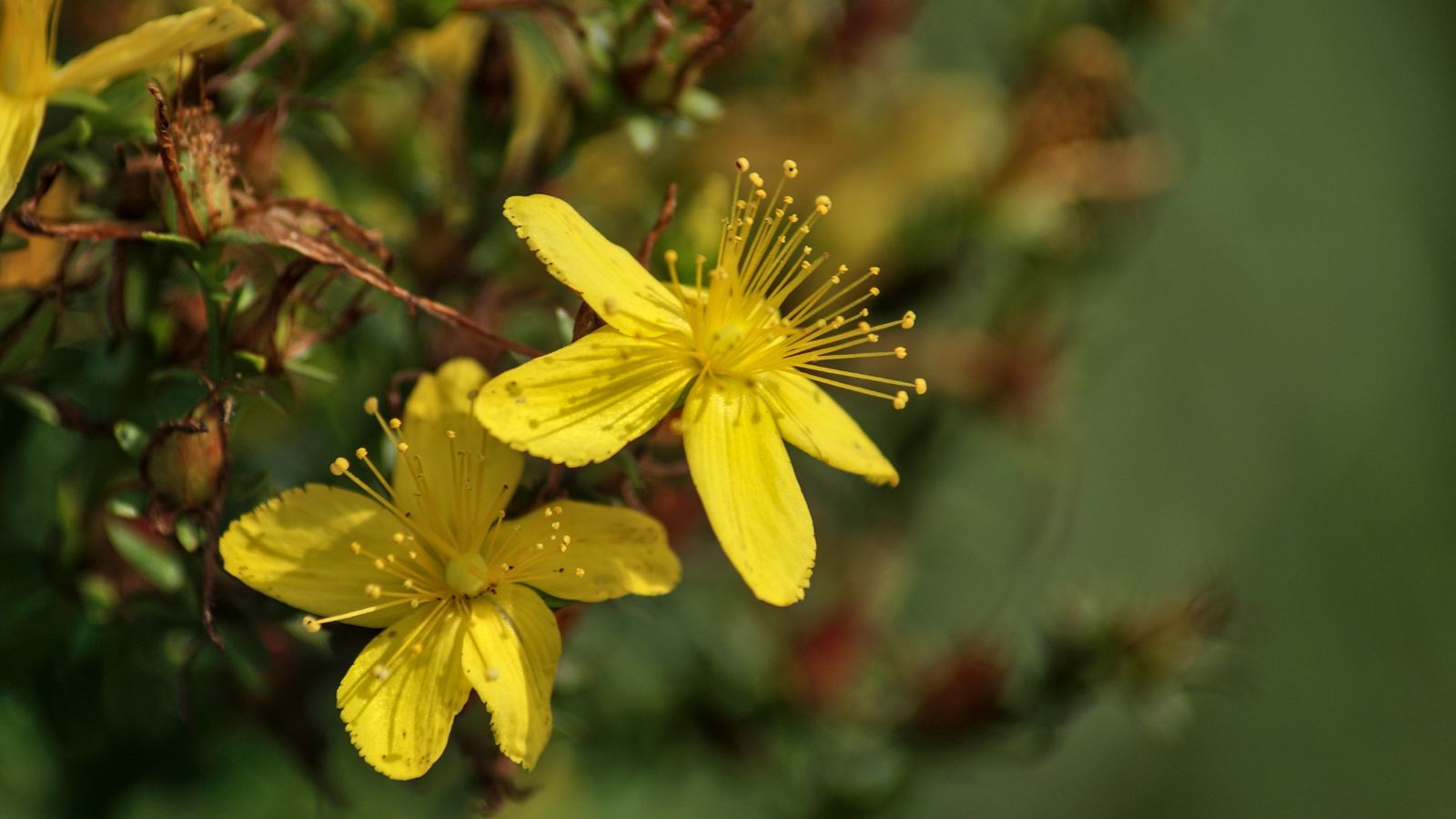
A common weed like purslane, St. John’s wort is a small perennial or annual shrub with dainty yellow blossoms. It sprouts from a thick root system belowground, allowing it to die back and grow anew during harsh seasons. Extremely drought tolerant, this herb is from Europe but naturalizes itself throughout North America. It is classed as an invasive species all over North America. Opt for native (Hypericum prolificum) St. John’s wort in its invasive regions.
St. John’s wort is a self-spreader; it uses hundreds of seeds yearly to spread into surrounding ecosystems. Cut the flowers before they form seeds, or keep this herb in a pot indoors to prevent it from invading local environments. The flowers and leaves make a mild, herbal tea. Mix in lemon and honey for superb flavor.
This herb is a close relative of the common garden plants of the same species Hypericum. St. John’s wort and its relatives may cause allergic reactions in some people; be cautious before ingesting it. Avoid growing it where it’s invasive, or bring it inside as a houseplant to prevent its spread.
Lovage
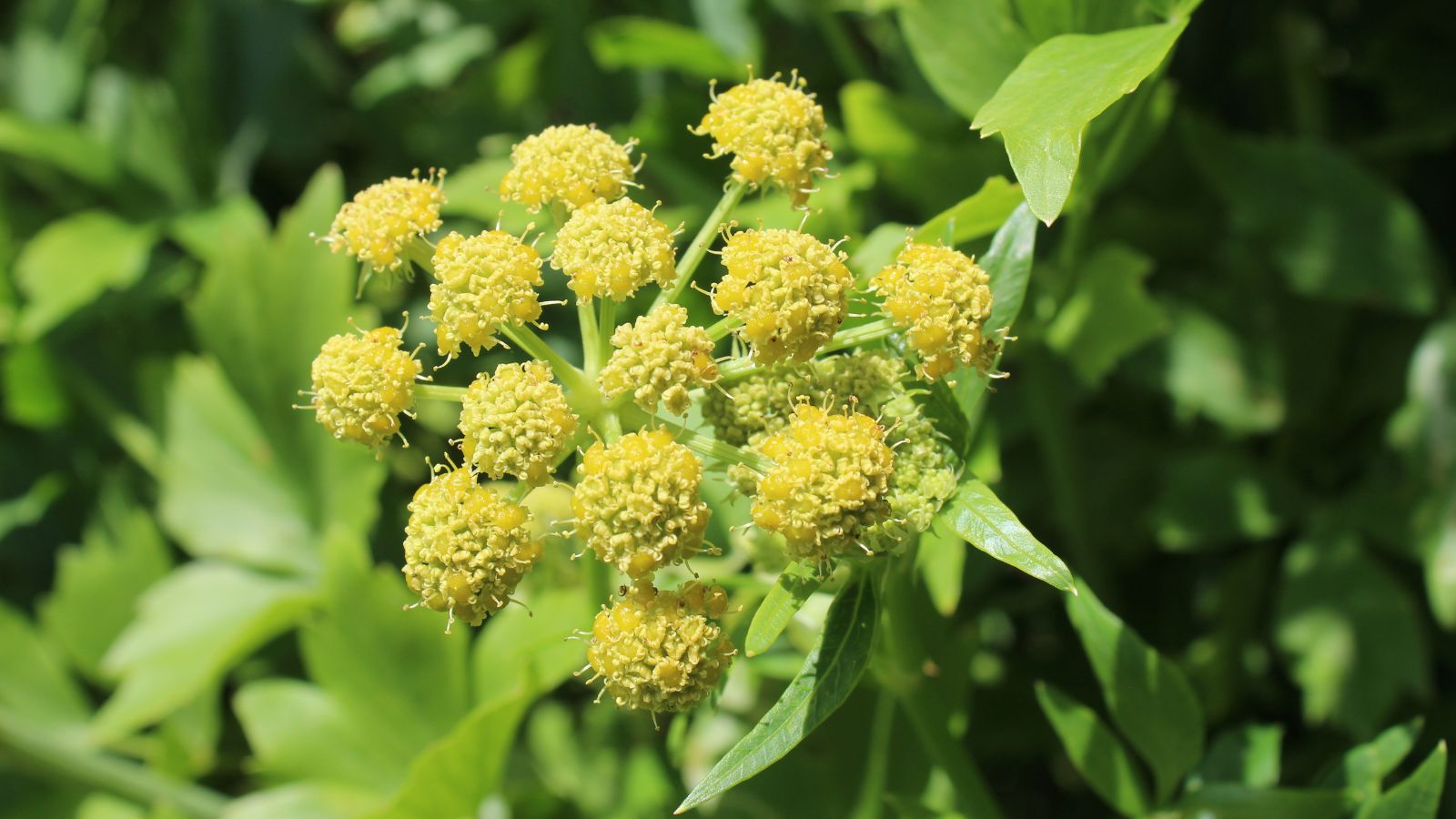
Lovage is a long-time favorite in traditional herb gardens. It adds a celery-like flavor to dishes with its edible leaves, flowers, and roots. Some chefs use the seeds, whole or grated, in recipes as a savory seasoning. The seeds grow from yellow umbel clusters that attract flies, bees, and beetles with nectar and pollen.
Lovage originates from the Mediterranean hills and adapts quickly to North American conditions. Cut the flowers before they form seeds to prevent unruly volunteer seedlings. Use flowers fresh or dried in tea, soups, or casseroles. You can also let lovage go to seed if you’d like to use those seeds for cooking. Cut the stems with seeds while they still hold onto the plant. Hang them in paper bags to dry, and the seeds will fall over time for easy collecting.
Start lovage from seeds, or find potted plants at your local nursery. They both sprout readily in spring after all danger of frost has passed. Grow lovage in raised beds, containers, or sunny borders, so long as the soil is rich and well-draining. This perennial thrives amongst other summer stunners like sunflowers, dill herbs, and nasturtiums.
Western Mugwort
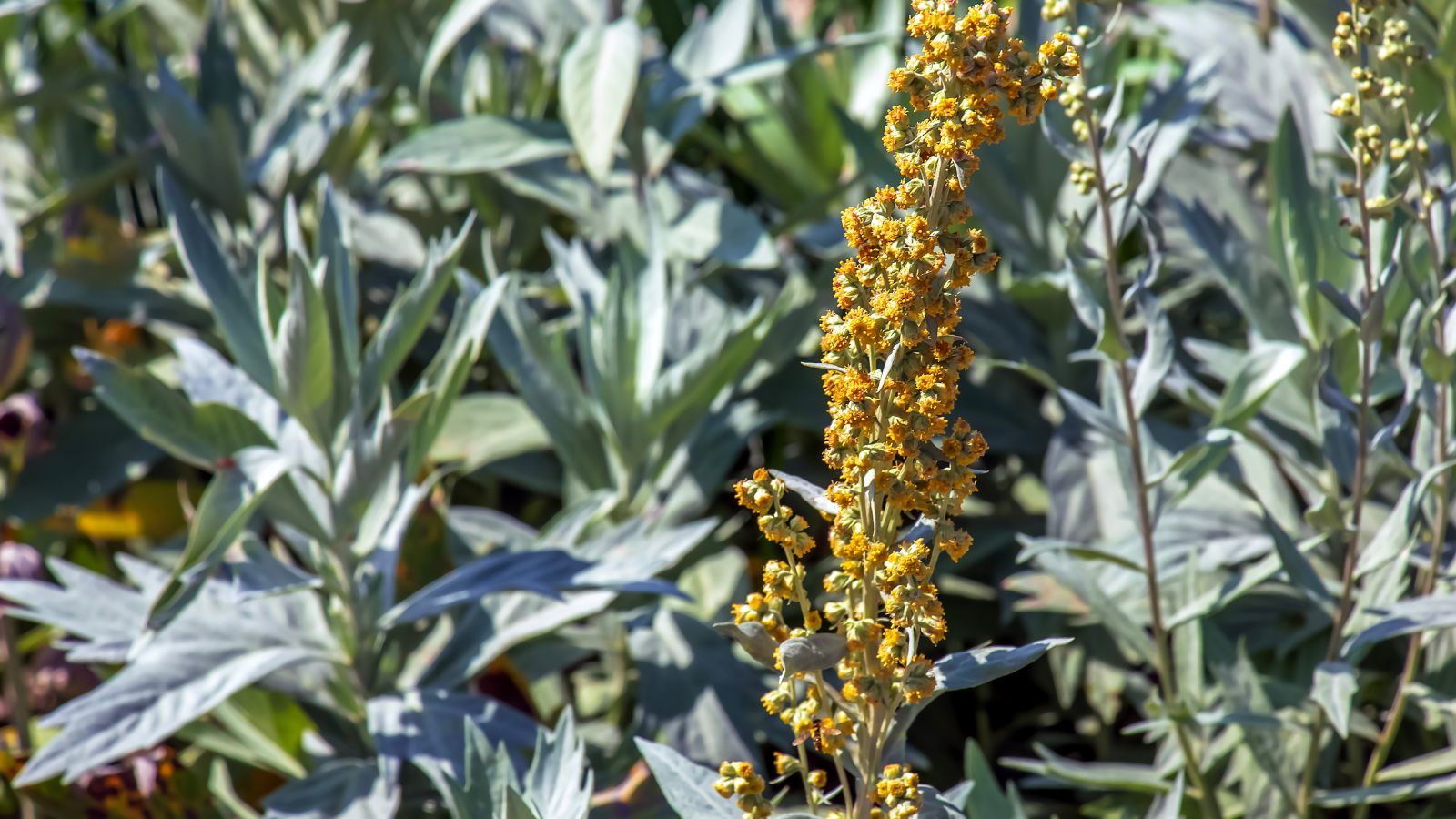
This native herb is a close relative of the absinthe-containing plant wormwood. Western mugwort looks like other species in the Artemisia genus; it has green leaves with gray-white fuzz on the undersides, and this foliage is incredibly fragrant. Use western mugwort as you would other drought-tolerant perennials in xeriscaping, containers, and dry borders.
This wormwood relative sprouts yellow flowers that aren’t too showy. They attract pollinators and add a nice pop of color to gardens they sprout in. Yellow flowers morph into seed clusters that spread this herbaceous perennial far and wide. It also spreads underground through rhizomatous root growth. If you wish, you may restrict it from spreading by cutting off spent flowers and pulling up any unruly seedlings.
Start western mugwort from seeds in early spring. You may also find this plant readily available at local nurseries in the western parts of the United States. Transplant mature mugworts after all danger of frost has passed. Don’t worry if your plants die back during autumn—they’re herbaceous perennials and will sprout anew in spring.
Mullein
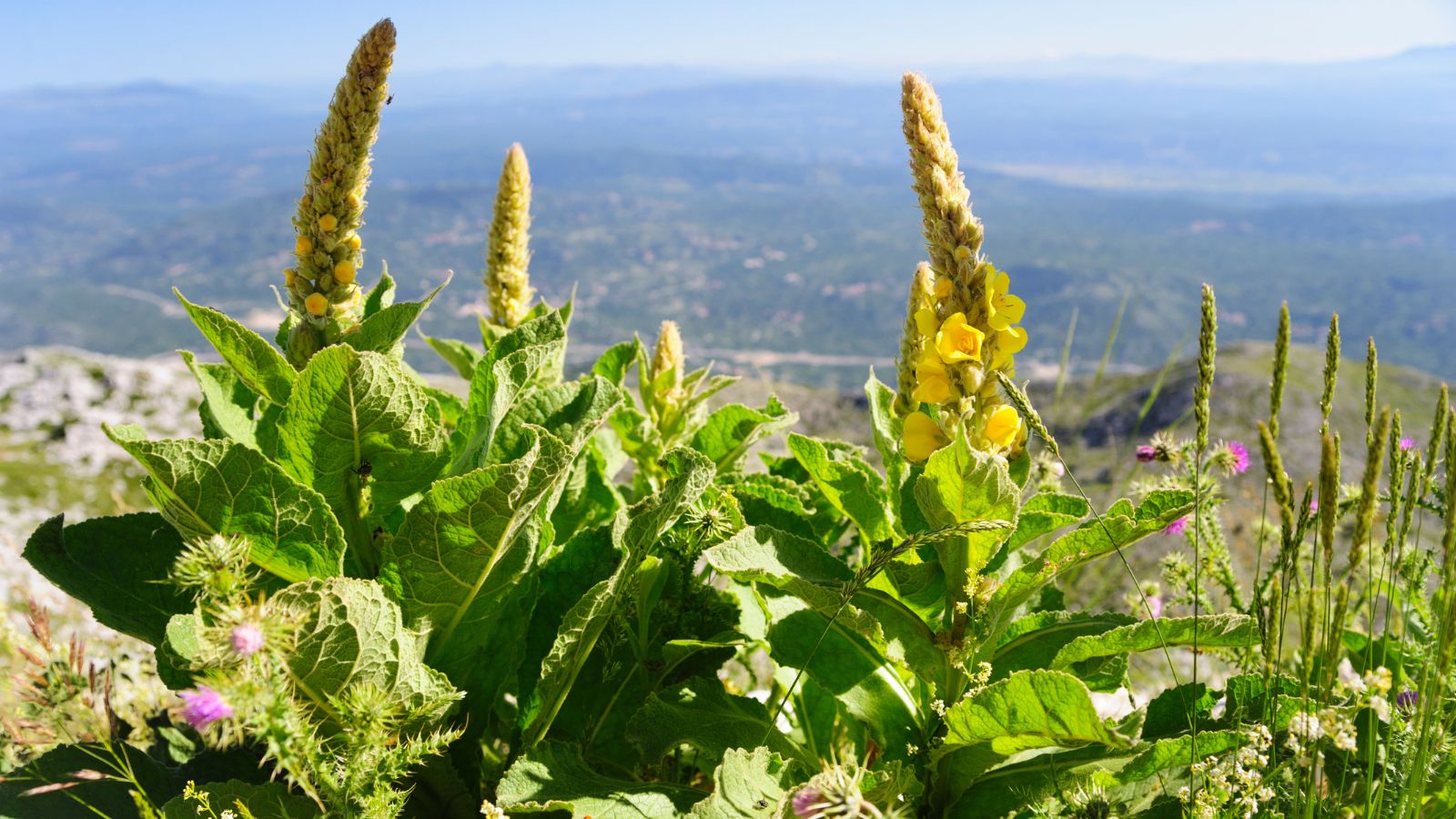
Mullein is a weedy species with a long history of naturalizing in the U.S. It originates from Europe and Asia, although it thrives now throughout all 50 states. Look for long, fuzzy leaves, and tall flower spikes with small yellow flowers. Mullein is biennial, meaning it produces a rosette of furry leaves in its first year, and flowers and seeds in its second year.
Mullein makes a soothing tea—simply brew the leaves or flowers to make the tea, and mix in honey and lemon to give it a soothing mouth feel. You can also make a silky smooth face lotion by infusing mullein leaves with cream or beeswax.
Start mullein from seeds in the fall or spring. Keep it in a container to limit its spread, and cut off spent flowers so they don’t produce seeds. One plant can create hundreds of thousands of seeds, and they spread into natural ecosystems. Like St. John’s wort, you may grow this species indoors or in a container—that way, you can use the herb while preventing its invasive spread.
Elecampane
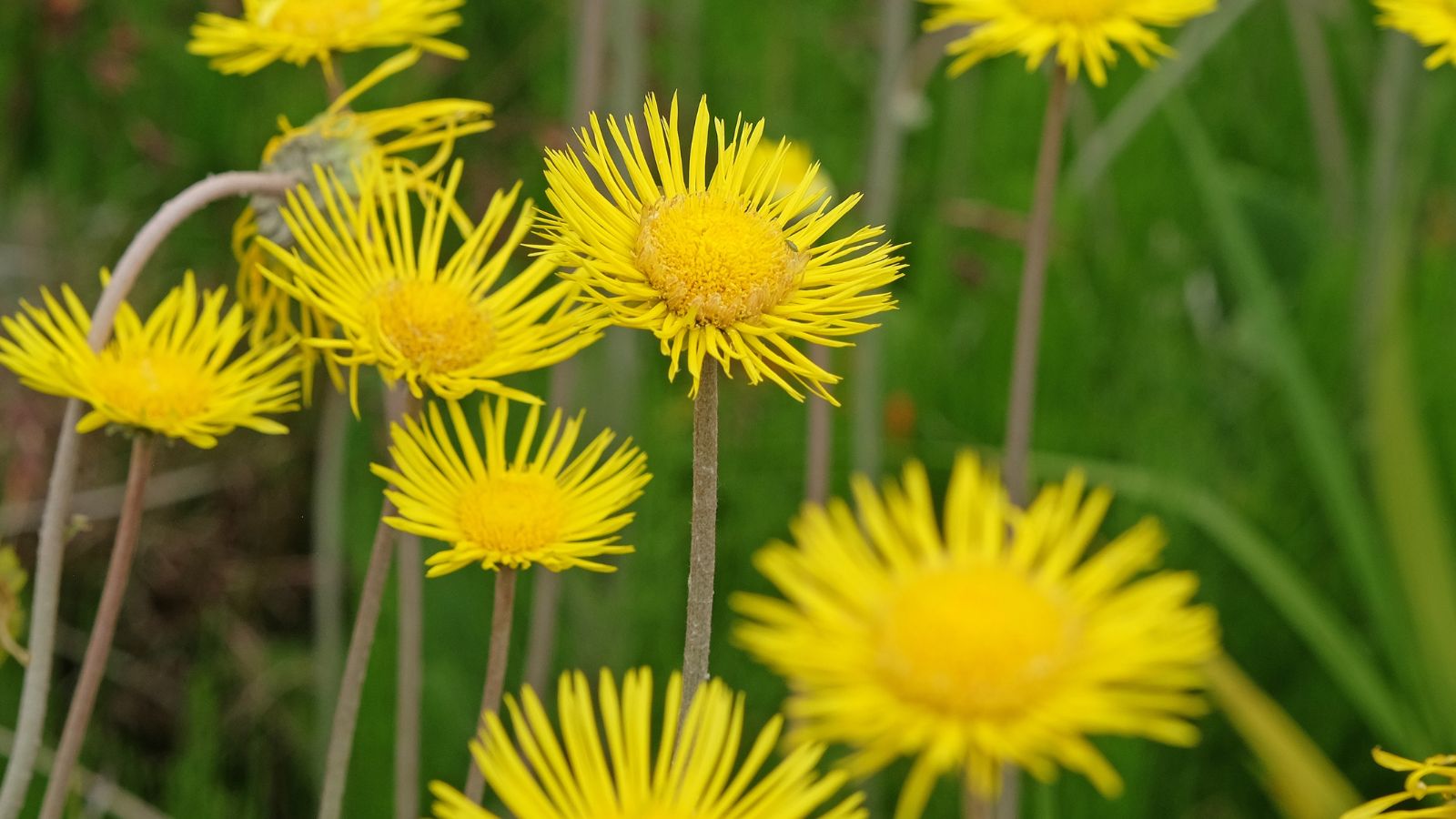
This yellow bloomer adds charm wherever it grows. In midsummer, it sprouts six feet tall stalks that erupt with yellow sunflower-like blooms. These attract pollinators to the site, despite this fact that this plant originates in Eurasia. Elecampane naturalizes itself in North America, and you’ll find it growing in disturbed soil, roadsides, and farmland.
This herbaceous perennial grows from seeds and rhizomes, much like western mugwort. Cut spent flower stalks to encourage more flowers to appear—slicing the stalks off also helps seeds stay out of natural spaces. Use elecampane roots to brew a soothing tea. This herb has a long history of medicinal usage, although nowadays, it’s more common as an ornamental garden plant.
Start elecampane from seeds in spring. Situate them in full sun, and give them afternoon shade in the hottest zones. This perennial sprouts each spring in zones 3 through 7, so you’ll have elecampane blossoms for decades if you plant one today. Note that the plant can be invasive, and may cause contact dermatitis in certain people.
Tansy
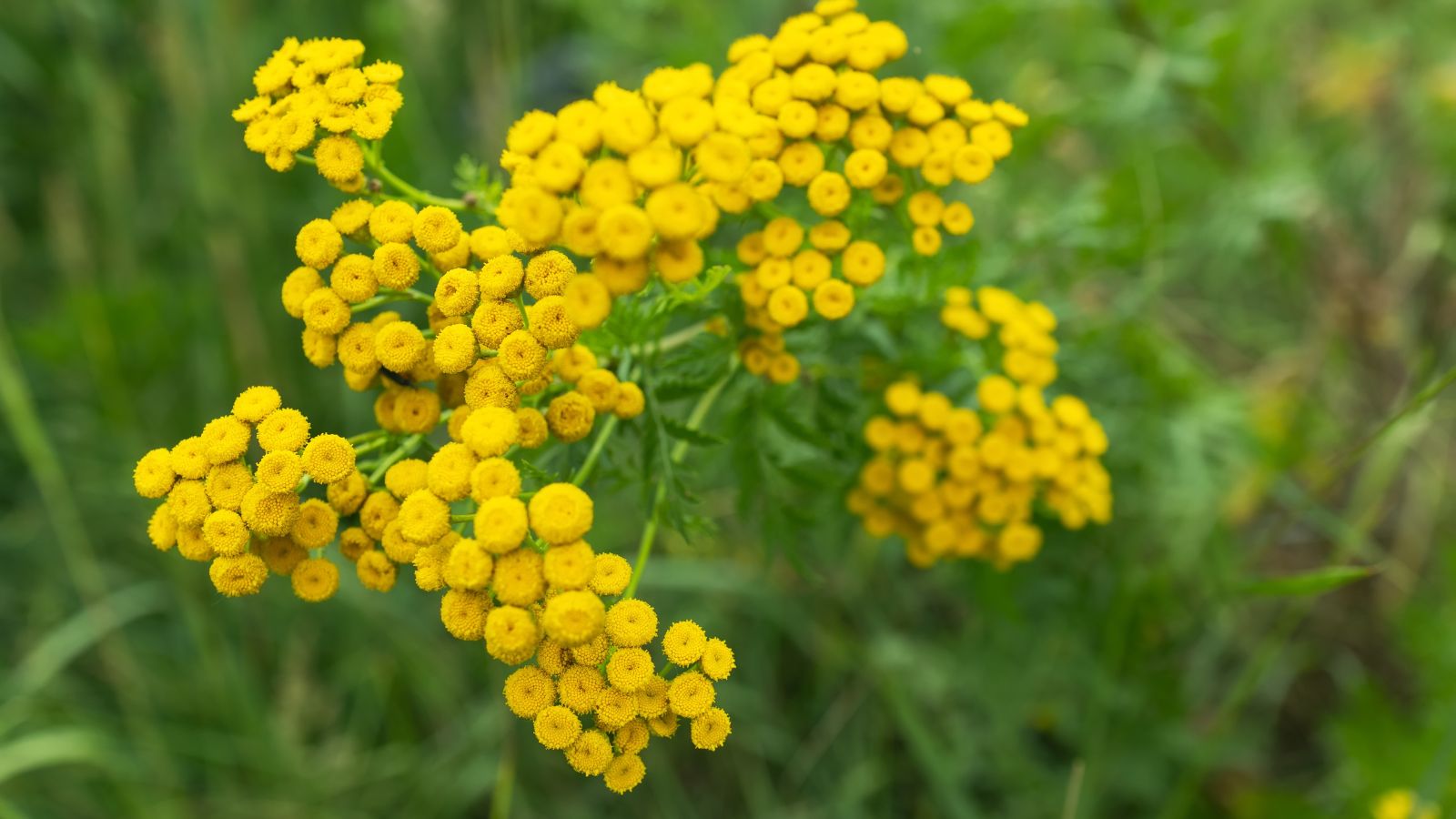
Tansy’s unique flowers and aromatic foliage are two main reasons this plant is common worldwide. It originates from Europe and Asia but resprouts readily in North American landscapes. It uses seeds and rhizomes to spread, making it an effective and invasive weed like St. John’s wort. Avoid planting it in states where it’s a noxious weed, as it readily invades ecosystems and displaces native plants.
Keep tansy in a container to further reduce its spread. Cut flowers as they bloom and bring them inside for dry or fresh floral bouquet arrangements. Avoid using this herb for tea or medicine, as it may cause allergic reactions in some people. Only use plants that you can safely identify, and use plants like tansy in moderation to avoid adverse effects.
Start tansy from seeds or rhizomes—plants sprout perennially from underground root structures. Transplant seedlings or rhizomes in spring after your last average frost date.
